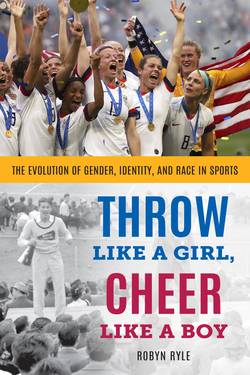Читать книгу Throw Like a Girl, Cheer Like a Boy - Robyn Ryle - Страница 4
На сайте Литреса книга снята с продажи.
Introduction
ОглавлениеI love sports. I love playing sports, whether it was tennis in high school or intramural flag football as a graduate student. I love watching sports, especially football and baseball and soccer. I love thinking about sports from a sociological perspective, which means asking a lot of questions about why sports are the way they are, as well as paying attention to the relationship between sport and inequality. Most of all, I love talking about sports. If there’s a way to bring up sports in the college classrooms where I teach, I’ll find it. About half of the conversations my partner and I have on a daily basis are about sports, which might sound insane, but is actually true.
I wrote this book because I love sports in all those ways. I love sports in the best sense of what it means to love something, which is to say, not blindly or uncritically. I love sports even though I believe they could be better. I’m there even through the flaws and the imperfections. I’m always rooting, not just for my favorite teams, but for sports to become a fairer and more just world. That’s part of what this book is about—the quest for a better sports world.
This book is also a journey into the ways sports can teach us a lot about the wider world. The transition in cheerleading from all men to almost all women teaches us important lessons about gender segregation, not just in sports, but in the workplace as well. The history of gender testing in sports reveals the flaws in many of our everyday assumptions about what gender is. Asking questions about the differences between women and men’s athletic abilities challenges our ideas about what we mean when we talk about gender differences in the first place, as well as why we’re so obsessed with proving who is better or worse at one thing or another. When we consider how to include transgender athletes into sports, we are forced to question what the very purpose of playing should be. Looking at sexuality in sport leads to an interrogation of the connections between gender and sexuality that exist in larger society. Sports can also serve as a mirror of the history of how power has been distributed on a global level and how categories of race and ethnicity have been created and then changed over time. Finally, sports activists can provide role models for making our world more equal and just. There is a lot to learn from sports if you ask the right questions, and that’s what we will be doing in this book.
This book is for fans of all kinds of different sports, from cheerleading to soccer to polo to cricket to figure skating. It’s also for people who are only mildly interested in sports, but want to know more about the history of gender, sexuality, and race as seen through a unique lens. In this book, you’ll learn a little bit of sociology and a lot about sports through a historical and cross-cultural perspective. There is so much more to say about the connections between sport, gender, race, and sexuality than can be contained within these pages, so hopefully, this will serve as an introduction to this fascinating world.
Sports can make us laugh and cry. They bring us together to cheer on a team. Sometimes they pull us apart, divided over who gets to play and how and whether they should be able to use their athletic platform to push for social change. Sports give us joy, and it is out of my own joy of sports that this book emerges. I hope this book broadens that joy for readers with a deeper knowledge of where sport has been and the hopeful directions in which it might go.
